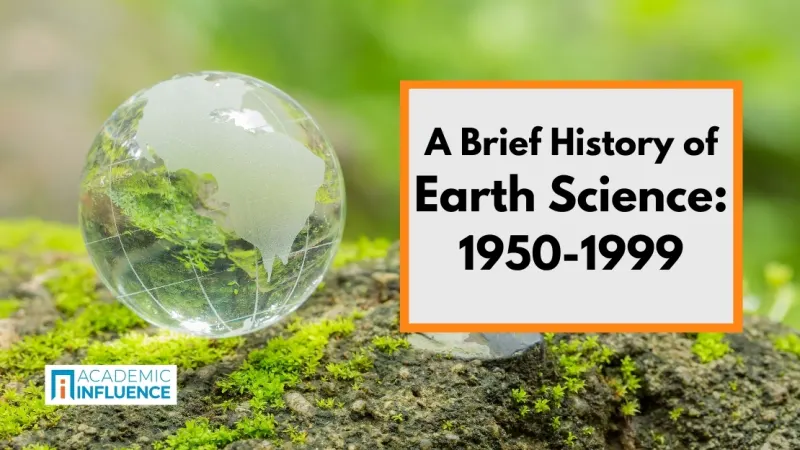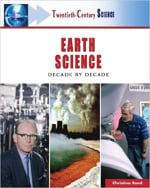A Brief History of Earth Sciences: 1950-1999

We explore the field of earth science from 1950-1999.
The second half of the twentieth century saw the end of the decade-long debate over plate tectonics. Arthur Holmes , the intellectual giant from the first half of the 20th century, played a big role in refining the theory of plate tectonics. Alfred Wegener (1880-1930) had proposed that continents moved like icebreakers, plowing through the oceanic crust. Holmes suggested that both continents and the oceanic crusts floated on top of a viscous mantle substrate. Both men, and many others, set the stage for a dramatic revolution of thought that occurred in the 1960′s.


Prior to the 1960s, even Arthur Holmes was at times reluctant to advocate for the theory of plate tectonics. The overall mindset of most earth scientists was against anything that disrupted the status quo—both in the sense of the way earth science was being taught and in the sense of the way the continental plates were arranged. All that changed when Marie Tharp (1920-2006) and Bruce C. Heezen (1924-1977) attended a National Academy of Sciences meeting moderated by Harry Hess (1906-1969). Tharp and Heezen had convinced themselves that the Americas were moving west away from Africa and Europe. When they showed Hess their map of the global underwater ridges they had painstakingly charted, Hess was also convinced, and published his thoughts as a 22-page manuscript, History of Ocean Basins, in 1962, which for several years was the most cited publication in the Earth Sciences.
It took less than a decade after that for nearly every earth scientist to accept that the theory of plate tectonics was, in fact, an accurate and likely explanation for the observed behavior of the earth. With that controversy out of the way, the stage was set for earth scientists to turn their attention to monitoring the earth for man-made and natural disasters. One key resource in that effort was the advent of artificial satellites. For example, in 1972, the first of nine Landsat satellites was launched in what would become the, thus far, longest-running program for imaging the earth from space.
As the various fault lines between different continental and oceanic plates were studied, new building codes and safety measures were enacted to mitigate the dangerous effects of earthquakes and tsunamis. At the same time, early warning systems were put into place to help evacuate people away from paths of volcanic eruptions, tsunamis, and tropical storms. The explosive eruption of Mount St. Helens in 1980 caused scientists around the world to campaign for monitoring stations on all active, or potentially active, volcanoes. But even with increased awareness, and despite indefatigable efforts on the part of dedicated scientists, 23,000 people died in Columbia in 1985 because of a failure in early warning efforts to alert the populace of an imminent volcanic eruption.
As the final years of the millennium ticked down, James Hutton’s old friend catastrophism returned to the scene in glorious fashion. The father-son duo Luis and Walter Alvarez uncovered strong evidence that the so-called Chicxulub impactor had struck the earth near the Yucatan Peninsula of Mexico near the end of the time of the dinosaurs. This ~6 mile in diameter meteor caused a blanket of ash to cover the globe, forming a layer of rock known as the Cretaceous–Paleogene boundary (also called the Cretaceous–Tertiary, or K-T boundary), and may have plunged the earth into a prolonged period of reduced sunlight, dooming the already declining dinosaurs to extinction as plantlife withered on a global scale.
Scientists generally agree that this event triggered 75% of plant and animal species to go extinct, including the non-avian dinosaurs. “Why did the dinosaurs go extinct?” is a favorite question of young and old alike. For earth scientists to have solved this riddle, and in a way that warns us against polluting our atmosphere, was a marvelous accomplishment and a fitting end to the 20th century.
Find out which influencers have most contributed to advancing the field of Earth Sciences over the last two decades with a look at The Most Influential People in Earth Sciences, for the years 2000–2020.
And to find out which schools are driving the Earth Sciences field forward today, check out The Most Influential Schools in Earth Sciences for the years 2000-2020.
Or, continue exploring the fascinating history of the Earth Sciences discipline with a look at a Brief History of Earth Sciences: 2000-2020.
Get more study tips, learning tools, and study starters with a look out our Complete Library of Study Guides.
Or jump to our student resource library for tips on everything from studying to starting on your career path.